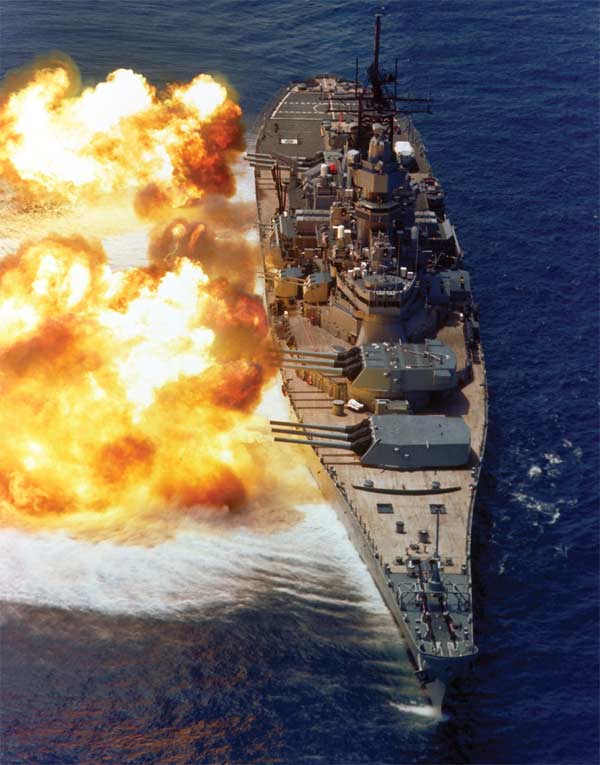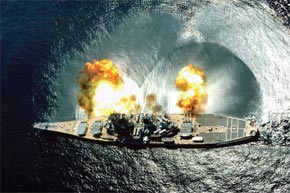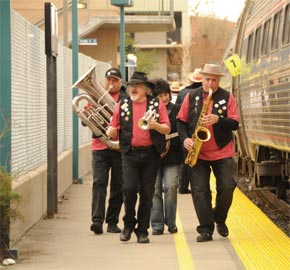
USS Iowa (BB-61) was the lead ship of a class of battleships built during World War II. The four ships of this class, Iowa, Missouri, New Jersey, and Wisconsin, were designed to operate as an integral component of a “fast carrier task force.” This meant their primary focus would be defending aircraft carriers against surface and aerial attacks, providing gunfire support for invasion forces storming a beachhead, and interdicting enemy supply and transportation systems along coastlines. While they were not designed to be “heavyweight brawlers,” they carried the armor and firepower needed to fight toe-to-toe with the capital warships of the Axis powers.
The 887-foot long ships could steam at high speed (33 knots) yet, having a 45,000 ton displacement, were protected by heavy armor. The main gun battery consisted of three turrets, each with three massive 16-inch guns, which could hurl crushing salvos of nine 2,700 pound projectiles at targets up to twenty-three miles away. During World War II, the Iowa class ships carried a massive array of 5-inch, 40mm and 20mm anti-aircraft guns. As an unintended by-product of the Navy’s design considerations, these ships are not only the most powerful battleships ever built by the U.S., but are among the most elegant as well.

Iowa was the only ship of her class to serve in both the Atlantic and Pacific Oceans during the war. She was commissioned in February 1943, with Secretary of the Navy Frank Knox presiding over the ceremony. That fall, she carried President Franklin D. Roosevelt across the Atlantic to Casablanca en route to a crucial meeting in Tehran with British Prime Minister Winston Churchill and Soviet leader Josef Stalin. In support of this mission, a square bathtub was installed in the Captain’s quarters, as well as an elevator to shuttle the wheel-chair bound President between decks. Iowa is the only modern U.S. Navy battleship to carry a bathtub as part of its amenities!
When transferred to the Pacific Fleet in early 1944, Iowa shelled beachheads at Kwajalein and Eniwetok atolls in advance of U.S. amphibious landings. Later, as part of Fast Carrier Task Force 58, she supported carrier strikes against the Marianas Islands, including Guam and Saipan. Iowa often operated with the USS Hornet (CV-12), blasting enemy dive bombers and kamikazes from the skies around the battle fleet.
At the beginning of 1945, she left the war zone and entered an overhaul period at Hunter’s Point Naval Shipyard in San Francisco. In March, she rejoined the naval forces off Okinawa and participated in the invasion of that strategic island. Several months later, Iowa served as the flagship for Admiral William “Bull” Halsey during the Japanese surrender in Tokyo Bay. She was briefly decommissioned after the war.

However, Iowa was recalled to active duty to serve in the Korean War. For seven months in 1952, she was involved in raids on North Korea, smashing transportation, storage and industrial targets along the coast line with armor piercing and high explosive projectiles from her 16-inch guns.
In early 1958, she was decommissioned and placed into the Navy’s mothball fleet in Philadelphia, where she stayed for many years. Iowa was modernized in 1983 as part of a major naval expansion program and upgraded with the most advanced weapons systems available. These included Harpoon long-range anti-ship missiles, Tomahawk land attack cruise missiles, and Phalanx gatling guns for close-in anti-missile and anti-aircraft defense. Iowa was the first battleship to receive the RQ-2 Pioneer unmanned aerial vehicle, which was useful for aerial reconnaissance and gunfire spotting. Her firepower was unmatched by any other ship in the world short of a nuclear-powered aircraft carrier. She operated in both the Atlantic and Pacific Fleets to counter the recently expanded Soviet Navy.
During a practice gunfire session with her main gun batteries in April 1989, a horrific explosion wrecked her #2 gun turret and killed 47 sailors. The reason for the explosion remains somewhat of a mystery today, and the turret was never repaired. Initially, the Navy investigation pointed towards a homosexual sailor who was having problems with his partner. However, subsequent evaluations demonstrated that the powder bags, manufactured during World War II, had become unstable and may have simply spontaneously exploded when rammed into the gun’s breech before firing.
Iowa was decommissioned for the last time in 1990, and was initially struck from the Naval Vessel Register in 1995. She was reinstated from 1999 to 2006 to comply with federal laws that required retention and maintenance of two Iowa-class battleships as possible gunfire support platforms for the U.S. Marine Corps.
Iowa was berthed in Newport, Rhode Island when, in 1999, Senator Boxer, Senator Feinstein and Representative Pelosi secured a three million dollar grant from Congress to transport her to the west coast. They envisioned having the famous capital warship become a major San Francisco waterfront museum attraction, boosting the city’s economic environment.
In March 2001, Oakland-based Crowley Marine Services used the powerful ocean going tug Sea Victory to tow her 6,500 miles via the Panama Canal. The canal transit alone took three full days, with only eight inches to spare on either side of the Iowa as she was maneuvered through the locks.
To the delight of thousands of onlookers, the sleek battleship arrived in Suisun Bay on April 21, the most unique ship to be part of the local mothball fleet in decades. Having her become part of the “ghost fleet” is analogous to having Madonna move into your neighborhood. What once was a fairly quiet, unobtrusive group of gray ships now became a major tourist attraction in its own right. Passengers (and drivers) inside cars, buses, boats and trains passing along the Suisun Bay area, craned their necks to get a look at her distinctive clipper bow sticking out upriver at the end of row “G.”
Little did the Navy, or the ship’s former crew, realize that new battles were looming on the horizon. In an astonishing mid-July 2005 decision, the SF Board of Supervisors voted against allowing the Iowa to be berthed in the city, citing their opposition to the war in Iraq and the military’s policies regarding homosexuals (i.e., “don’t ask, don’t tell”). This paved the way for other California communities to bid for the battleship – and reap the resulting financial rewards.

By March 2007, several competing groups formed to obtain the Iowa for their community. The Historic Ships Memorial at Pacific Square (HSMPS), the same group who attempted to place the Iowa in San Francisco, now advocated locating her at the former Mare Island Naval Shipyard in Vallejo. Another group from Stockton led by Navy Captain Jim Dodge (who was instrumental in saving the USS Hornet) also submitted a proposal to the Navy. In October 2007, the Navy sent a letter to HSMPS stating that the Vallejo group was the only remaining viable candidate to acquire Iowa but their application would be further reviewed only after evidence of firm financing.
Unfortunately, our major nationwide recession soon took hold and the city of Vallejo wound up in serious financial difficulty. HSMPS was unable to raise enough money to persuade the Navy to make a final donation decision in their favor.
The magnificent battleship patiently waited in Suisun Bay, with her teak deck slowly rotting, as various organizations continued to spar over her fate. In September 2011, the Navy decided to donate Iowa to a non-profit group in Los Angeles called the Pacific Battleship Center. Late this year, the ship will be permanently moved to the Port of Los Angeles (berth 87 in San Pedro) to serve as a museum and memorial to battleships.
The USS Iowa has many historical connections to the SF Bay Area, including the Hunter’s Point Shipyard, FDR’s presidential yacht M/V Potomac and her WWII combat companion USS Hornet. One the surface, it would seem logical to keep her here as a museum. However, Iowa deserves to be cared for by people who understand the rich heritage of American battleships, and their role in protecting the democratic principles citizens of our country enjoy today. While the SF Bay Area has an impressive maritime legacy, much of its populace does not readily acknowledge nor embrace it. In the end, the Navy felt the Los Angeles area had a better chance of ensuring long term success of the museum.
Farewell Iowa, we enjoyed having you in our mothball fleet and we will miss you!
* * *
Commemorate Veteran’s Day on November 11 at the USS Hornet Museum. For more information, visit the museum website at www.uss-hornet.org or call (510) 521-8448, ext. 282.




